Thai Red Curry With Fish (Super Easy Recipe)
Looking for a quick and easy weeknight dinner? Look no further than this Thai red curry fish recipe. With only five essential ingredients, minimal chopping, and no compromise on authentic Thai flavours, this is the ultimate convenience dish.
I adore Thai food. And, this easy Thai red curry fish recipe is no exception. With minimal ingredients, you can have a delicious and authentic Thai meal on the table in no time at all.
And the best part? No chopping! Simply add your choice of white fish (like cod or snapper) and let it simmer in the creamy and spicy Thai coconut curry sauce until cooked through.
Steamed Jasmine rice is my ultimate Thai curry companion, but you can serve the spicy, creamy coconut fish curry with your favourite curry accompaniment. Always add a few lime wedges to the side and garnish generously with thinly sliced kaffir lime leaves (or Thai basil), and red chillies.
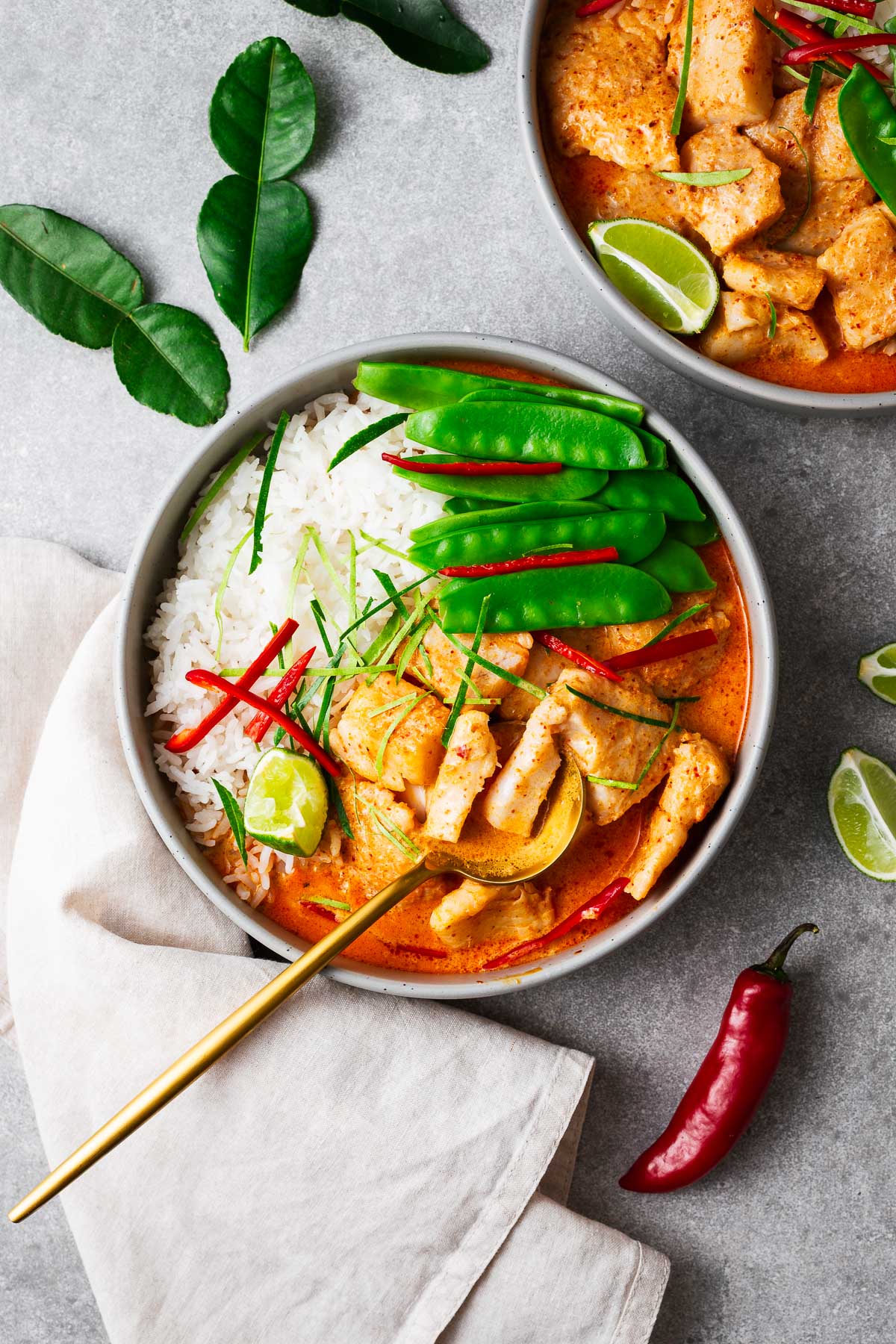
Why I love this Thai curry
- It is a quick and easy recipe that requires no chopping and only five essential ingredients – the ultimate weeknight dinner.
- With homemade or good quality store-bought red curry paste and coconut milk, this recipe is packed with traditional Thai cuisine flavour.
- Use any skinless white fish fillets with firm flesh for this flexible fish curry recipe.
- Serve it with quick-cooking vegetables (like snow peas, green beans, baby corn, or even asparagus) to customise the recipe to fit your fridge!
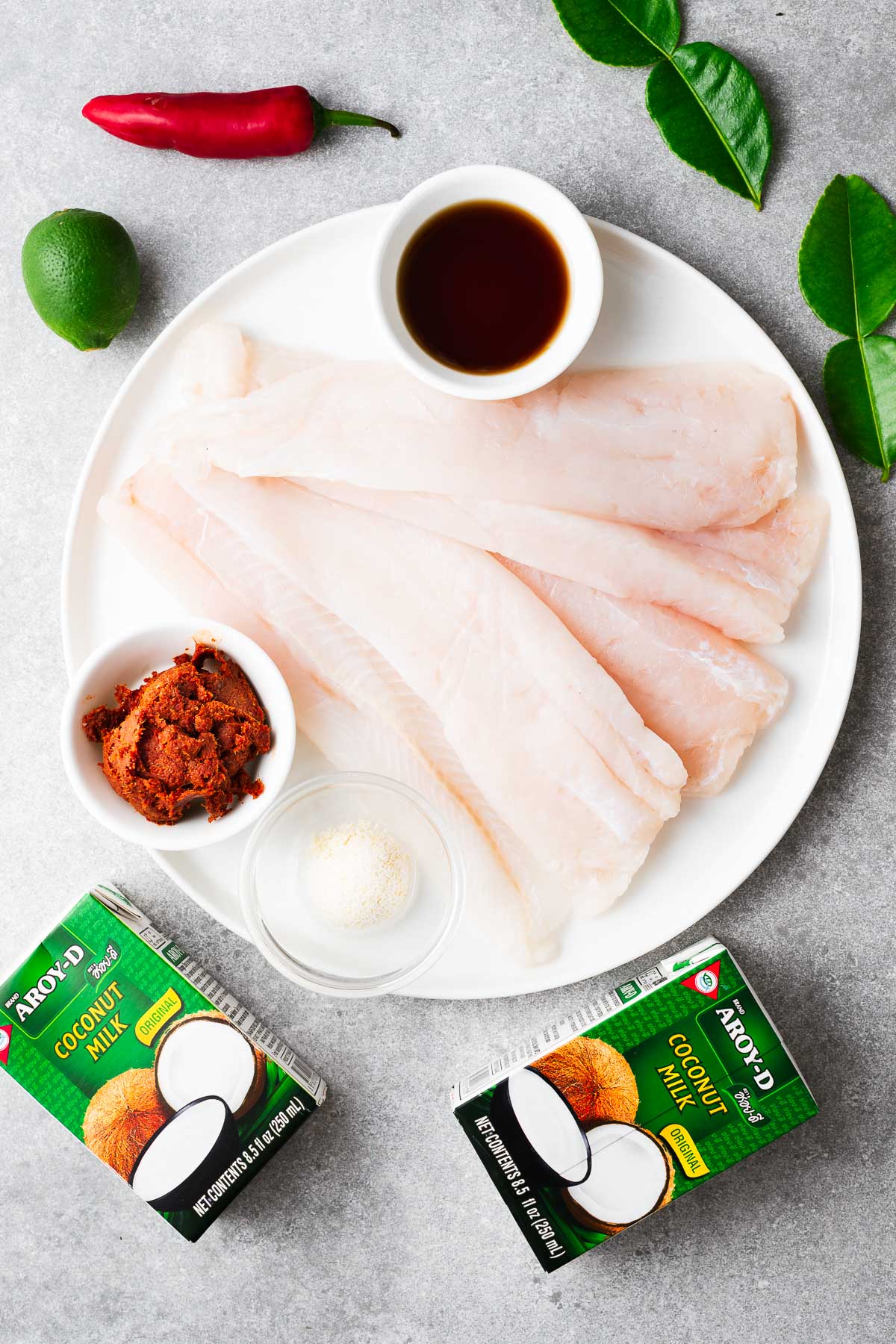
Key ingredients and substitutes
The key to a delicious Thai fish red curry is using fresh, quality ingredients. But, this simple recipe is also versatile, and you can easily substitute ingredients to suit your tastes or dietary requirements.
The five key ingredients in Thai fish red curry:
- Skinless white fish fillets: Use firm white fish, such as cod, hake, bass, grouper, tilapia, haddock, snapper, or dorado (mahi mahi). Thicker cuts work best, but any skinless fillet will work.
- Red curry paste: Use homemade red curry paste, or opt for a good quality store-bought version like Mae Ploy. You can also reduce the amount of curry paste for a milder curry. But don’t add more than the recipe calls for, or the result will be too salty.
- Coconut milk: Use full-fat coconut milk for a creamy and rich curry. If you only have a 14-ounce can (400 grams) of coconut milk, add water or unsalted vegetable stock to make up the difference. You can also use a combination of coconut cream and stock.
- Fish sauce: This is a staple ingredient in Thai cooking and adds a savoury umami flavour to the curry. I prefer the Thai Squid brand of fish sauce.
- Palm sugar: This adds a touch of sweetness to balance out the spice. You can use brown sugar instead if you can’t find palm sugar.
You’ll also need some cooking oil from the pantry (coconut oil or a neutral cooking oil) to give the red curry paste a quick stir-fry. While you can technically skip it, stir-frying curry paste in oil releases the most amazing oil-soluble flavours.
How to make Thai fish curry
Here’s a step-by-step guide to making a delicious Thai red curry with fish and coconut milk in just a few simple steps.
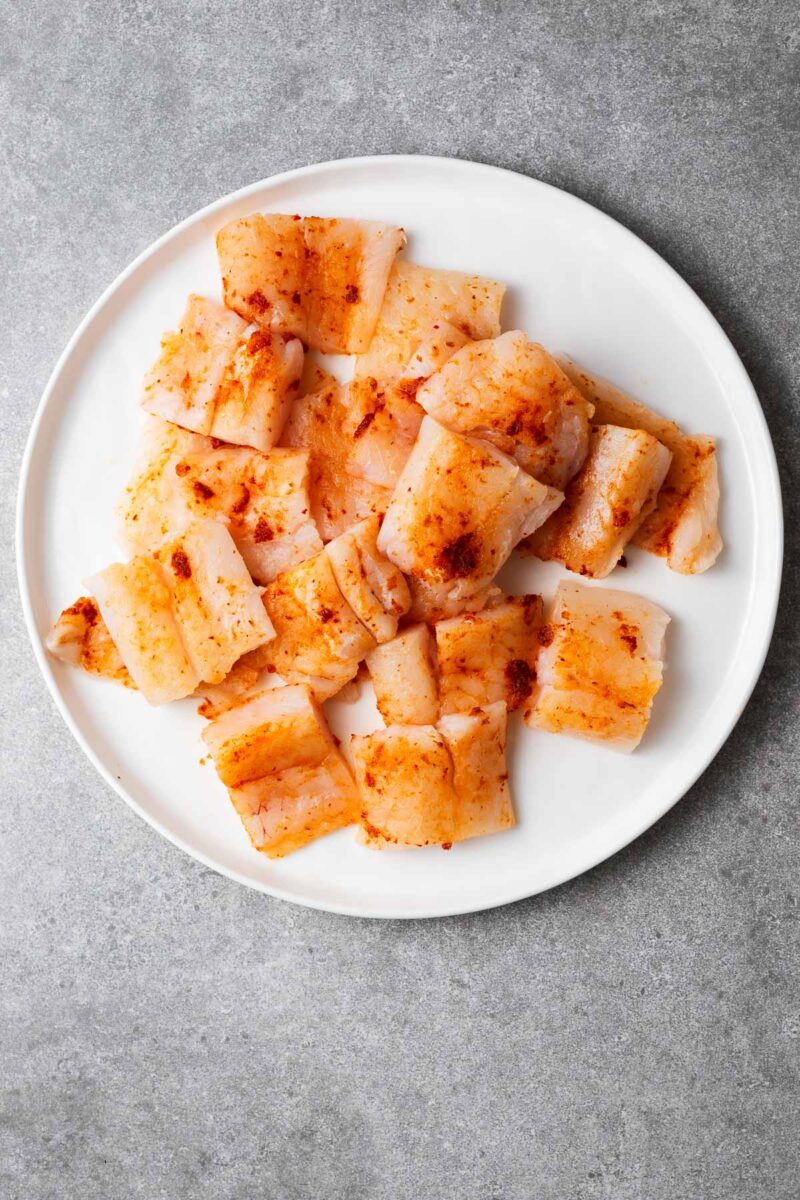

Step 1: Start by preparing the fish. Cut your fish fillets into large, even-sized chunks. Dry them with a paper towel and gently rub them with a thin layer of red curry paste to season. Set them aside.
Step 2: Heat the vegetable oil in a large saucepan over medium heat. Once the oil is hot, the red curry paste and stir-fry until it is fragrant and mixed into the oil – about 2 minutes.

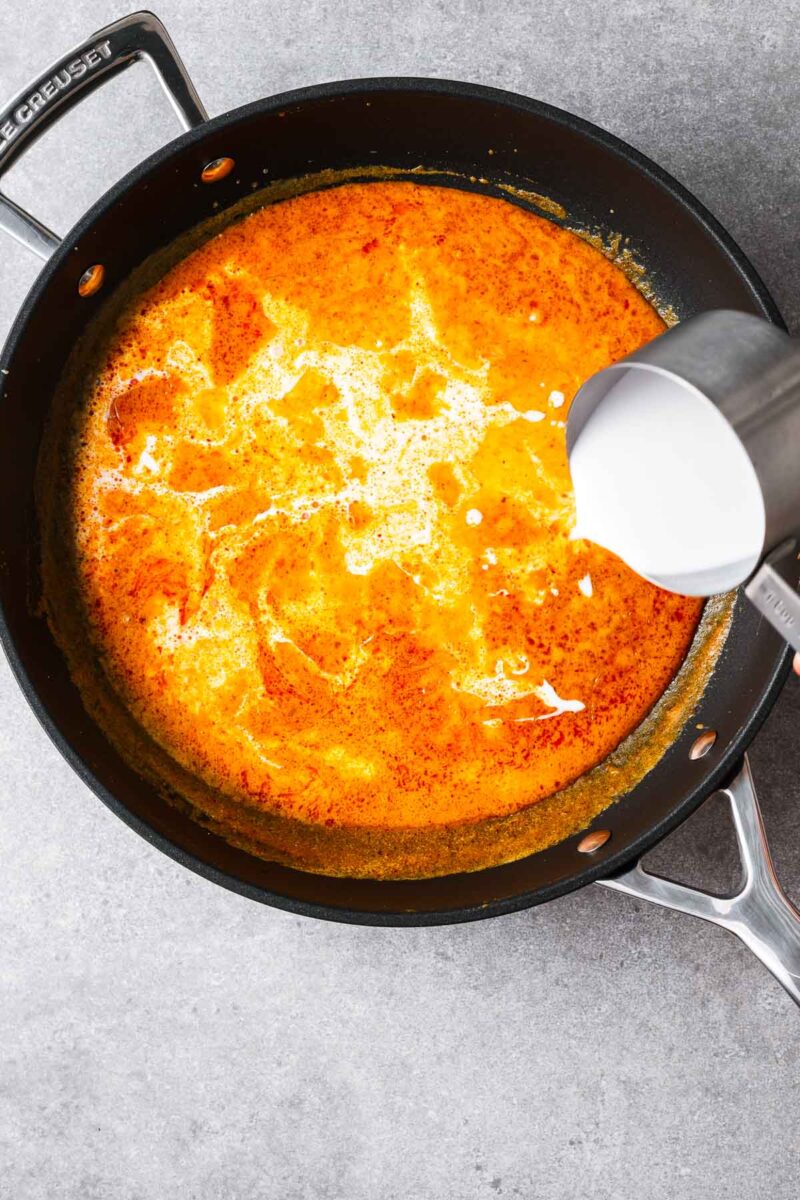
Step 3: Increase the heat to medium-high and add half of the coconut milk, all the fish sauce, and palm sugar. Bring the sauce to a boil, then reduce the heat to medium and cook, stirring often, until the sauce is smooth and thick – about 8 minutes.
Step 4: Stir in the remaining coconut milk. Taste the sauce and adjust the seasoning with more palm sugar. If the sauce is too salty, add more coconut milk or a splash of water. But remember that you’ll serve the sauce over rice, it needs to be punchy. Let the sauce come back to a light simmer.
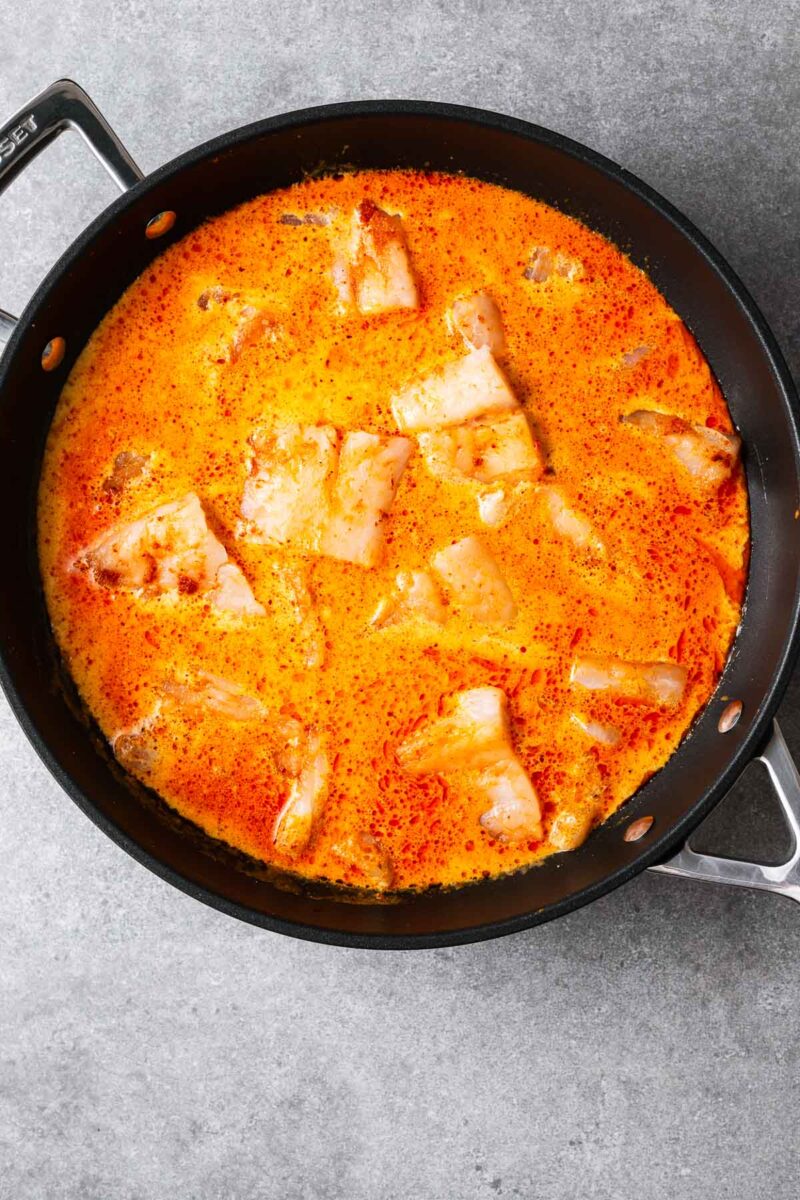
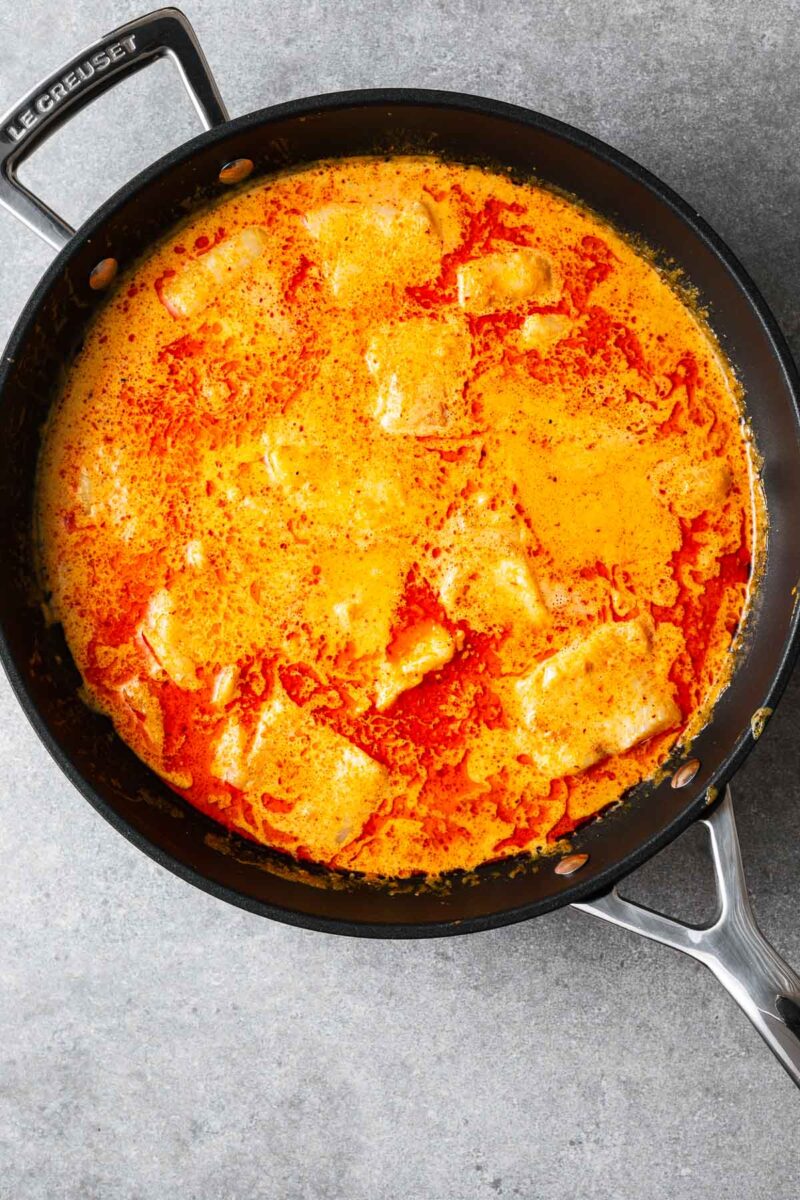
Step 5: Gently place the fish into the sauce and let it lightly simmer for seven to ten minutes, flipping the fish over once, until it is firm and opaque all the way through.
Serve the Thai fish red curry over steamed jasmine rice (or cauliflower rice) in individual bowls. Top each bowl with warmed snow peas, shredded herbs (lime leaves or Thai basil), and sliced chilli. Drizzle with fresh lime juice and enjoy!
Serving suggestions
Rice and friends: Ladle the curry over steamed white rice. I prefer the traditional Thai choice of steamed Jasmine rice, but you can also use brown rice, or cauliflower rice for a low-carb option.
Add veggies: Add quick-cooking veggies such as snow peas, sugar snap peas, baby corn, green or red bell peppers, or even asparagus spears. Add the veggies to your curry for the last minute or two of cooking, or blanch them separately (as I do) to guarantee tender fish and warm yet crisp veggies.
Garnish: Top your curry with thinly sliced strips of kaffir lime leaves (stem removed), Thai basil leaves, or whole sprigs of cilantro (fresh coriander). Add a thinly sliced red chilli for extra spice, or a drizzle of coconut milk (or coconut cream) to cool the curry down.
Limes are a must: Serve the curry with fresh lime wedges on the side. The acidity balances the salty, spicy, rich, umami-packed sauce.
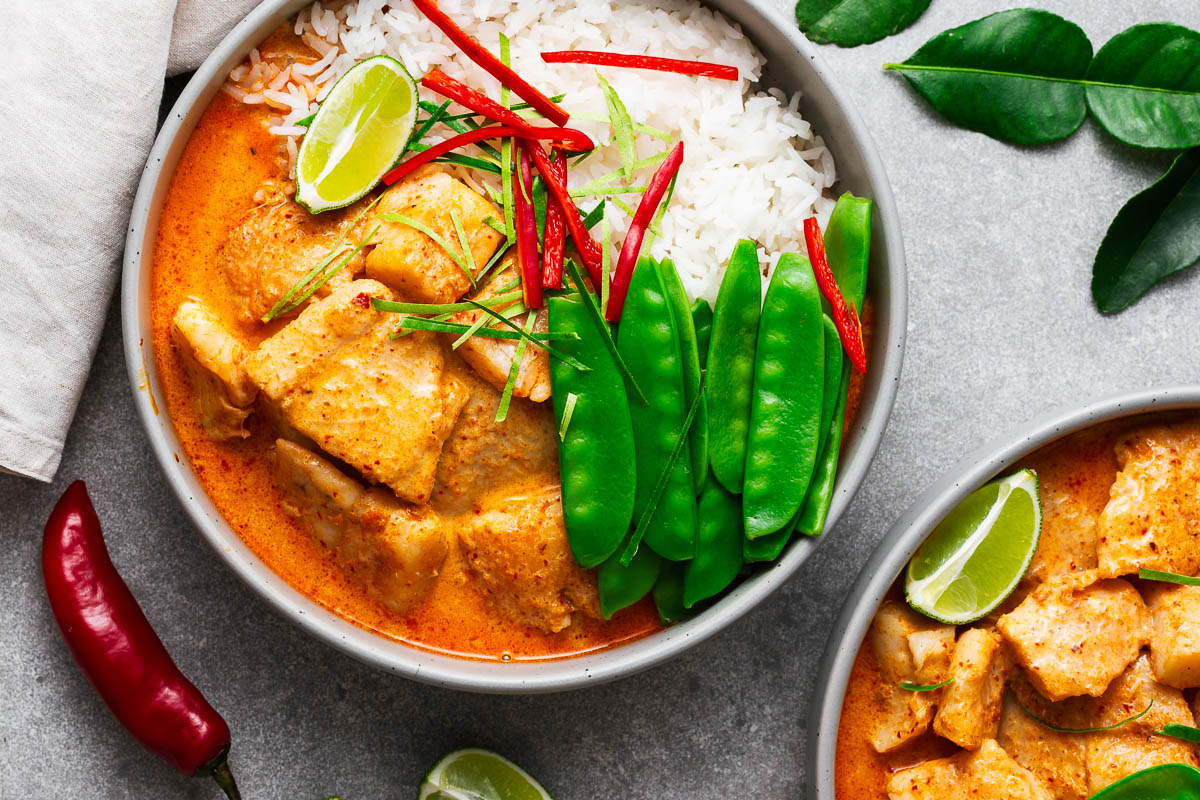
Frequently asked questions
The best fish for curry is firm, white fish such as sea bass, tilapia, cod, hake, or halibut. These fish hold up well in the spicy and flavourful curry sauce. Salmon and trout fillets also make delicious fish curries.
There are different types of Thai curry. Some are made with chicken, vegetables, shrimp, or tofu, and some curries have fish. The Thai curry sauce may also contain fish sauce as one of the key ingredients. And Thai curry paste typically contains shrimp paste.
The most traditional option to serve with Thai fish curry is steamed jasmine rice. But you can also serve it with brown rice, cauliflower rice, or rice noodles. Garnish the curry with fresh herbs, such as cilantro, makrut lime leaves, or Thai basil, sliced red chillies and lime wedges.
Red curry is a type of Thai curry that gets its red colour from the red chillies in the curry paste. Other Thai curries, such as Thai green curry and yellow curry, use different types of chillies and herbs in the curry paste, giving them their distinctive colours and flavours.
More Thai Recipes
- Authentic Thai Red Curry Paste
- Simple Thai Green Curry Recipe
- Easy Tom Yum Soup With Prawns (Thai hot and sour soup)
- Thai Green Mango Salad
- Prik nam pla: The Thai condiment to serve with everything!
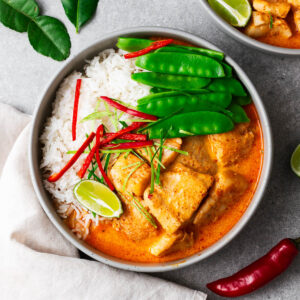
Ingredients
- 20 ounces skinless white fish fillets
- 3 tablespoons red curry paste* , divided
- 3 tablespoons vegetable oil , divided
- 2 cups coconut milk*
- 2 tablespoons fish sauce
- 1 tablespoon palm sugar (or brown sugar) , more to taste
To garnish
- 2 fresh kaffir lime leaves or Thai basil leaves , stem removed and finely sliced
- 1 red chilli , thinly sliced
- fresh lime wedges
To serve (optional)
- snow peas , or sugar snap peas
- steamed jasmine rice , brown rice, or cauliflower rice
Instructions
- Cut the white fish into large even-sized chunks. Dry it with a paper towel and gently rub the fish with a thin layer of red curry paste to season – you'll use about 2 teaspoons of the curry paste.
- Heat the oil in a large saucepan over medium heat. Once the oil is hot, add the remaining red curry paste and stir-fry until it is fragrant and mixed into the oil – about 2 minutes.
- Increase to medium-high heat, and add half of the coconut milk, all of the fish sauce, and palm sugar. Bring the sauce to a boil. Then, reduce the heat to medium and cook, stirring often, for about 8 minutes until the sauce is smooth and thick.
- Add the remaining coconut milk and mix well. Taste the curry sauce. It should be spicy, salty and slightly sweet. Remember that you’ll serve it over rice, so it needs to be punchy. Add more palm sugar and some salt if your sauce needs balancing. Depending on the brand of curry paste, I sometimes add another ½ tablespoon of palm sugar. Let the sauce come back to a light simmer.
- Nestle your fish into the sauce and simmer gently. Use a lid, if you have one, to speed things up. Check your fish after 5 minutes and gently flip them over if they’re not firm and opaque yet – cook for another 2 to 5 minutes. The exact cooking time depends on how thick the chunks of fish are. The key is to keep an eye on the simmering sauce and remove the saucepan from the heat as soon as the fish is firm and opaque all the way through.
- Serve the Thai red fish curry over steamed jasmine rice (or cauliflower rice) in individual bowls. Top each bowl with warmed snow peas*, shredded herbs (lime leaves or Thai basil), and sliced chilli. Then drizzle with freshly squeezed lime juice.
Notes
- You can use any skinless white fish fillets. Cod (and its subspecies like hake), bass, grouper, tilapia, haddock and snapper all work well. Thicker cuts work best if you have a choice.
- This super simple recipe relies on the flavours of quality ingredients and fresh fish. Use homemade red curry paste or good quality store-bought Thai red curry paste, like Mae Ploy red curry paste.
- For a milder curry, reduce the curry paste. You can always add more curry paste toward the end. But don’t add more than the recipe calls for, or it will be too salty. Rather garnish your dish with more sliced chillies.
- I buy full-fat coconut milk in small cartons from Thailand. If you have a 14-ounce can of coconut milk (400 grams), you don’t need to open a second can if you don’t have another use for the leftover coconut milk. Instead, add water or unsalted vegetable stock to make up the rest. And, if you have leftover coconut milk, drizzle a tablespoon of coconut milk over each finished Thai curry bowl as a garnish, or add it to the rice cooking liquid!
- You can add snow peas (or other quick-cooking vegetables like bok choy) directly to the simmering sauce for the last minute. But, I prefer to heat them separately to retain their sweet flavour, crispy texture, and vibrant colour. Simply place them in a heatproof bowl, cover with boiling water and leave for about 2 minutes. Drain and set aside until your curry is ready.
- Refrigerate leftovers in an airtight container for up to 3 days.
Try more easy Asian-inspired dinners
- Spicy Korean gochujang noodles
- Korean braised tofu (dubu jorim)
- Chinese tomato egg stir fry
- Japanese udon noodle soup (kake udon)
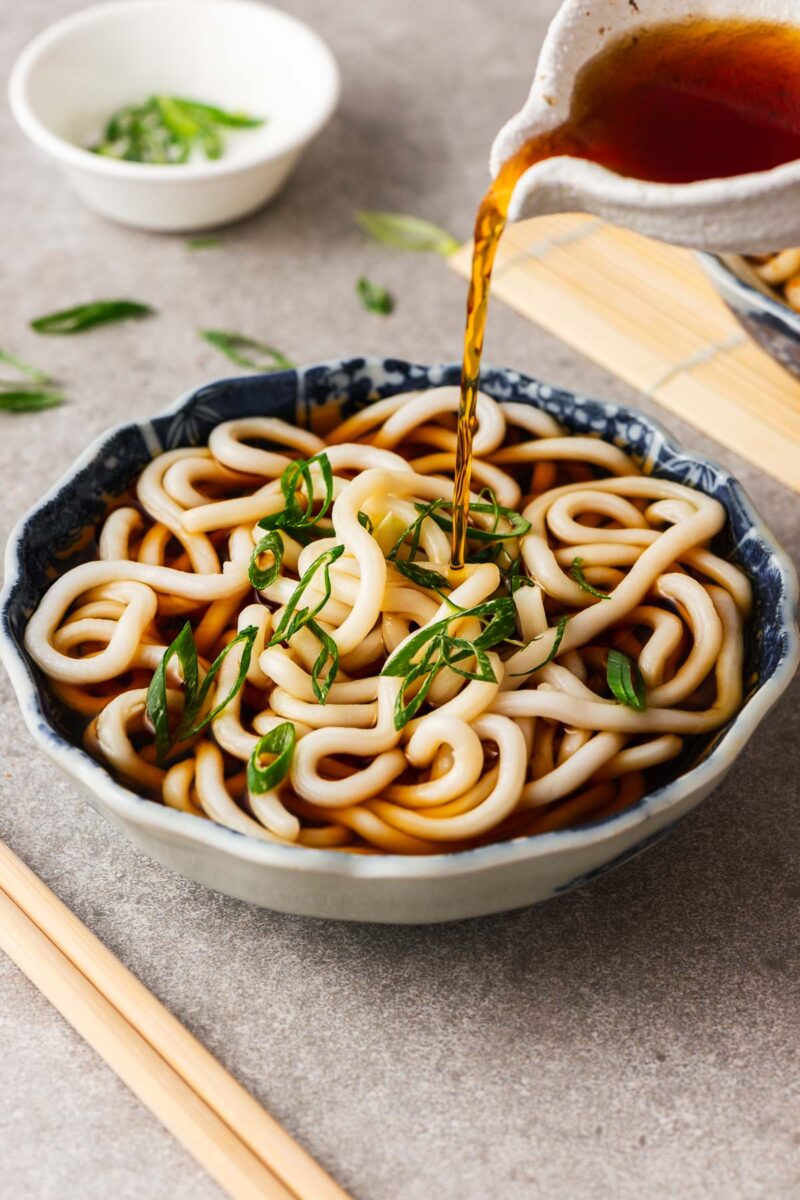
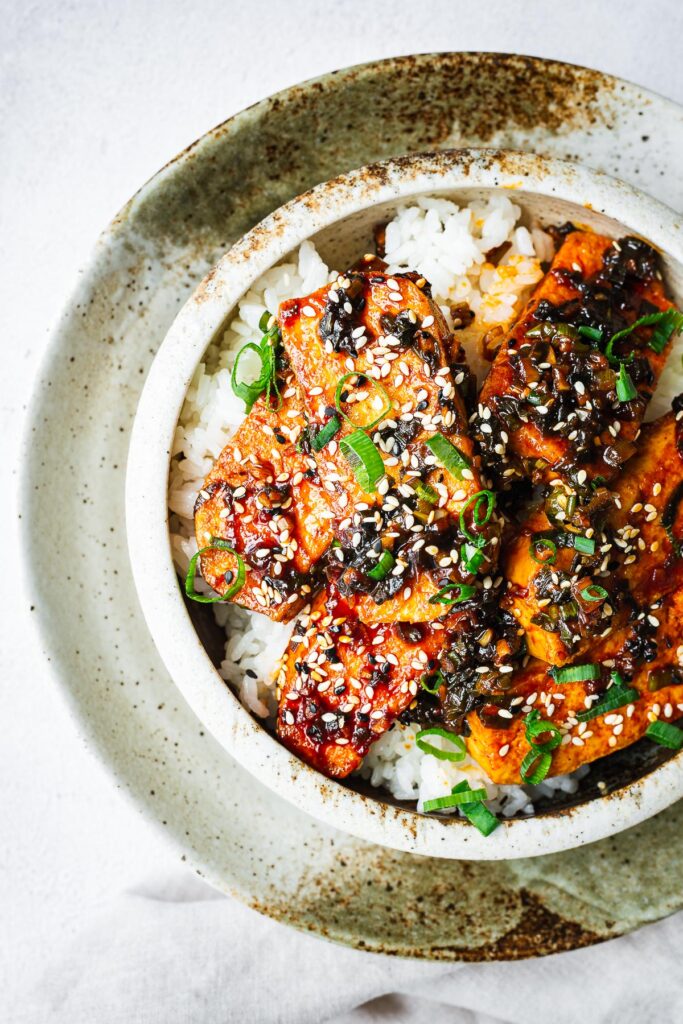

The blend of spices and the creamy coconut milk created a rich, flavorful dish that was surprisingly simple to prepare. I highly recommend it for anyone looking to enjoy a quick and delicious Thai meal at home!
I’m thrilled that you enjoyed this easy Thai red curry. Thank you so much for taking the time to leave a comment, Gianne!
The red curry with this fish was such an amazing, winning combo! Loved every bit of it! Thank you so much! It’s my new favorite fish recipe!
You are too kind, Ned! I am so happy you enjoyed the fish curry, it’s also my favourite way to cook fish at the moment!